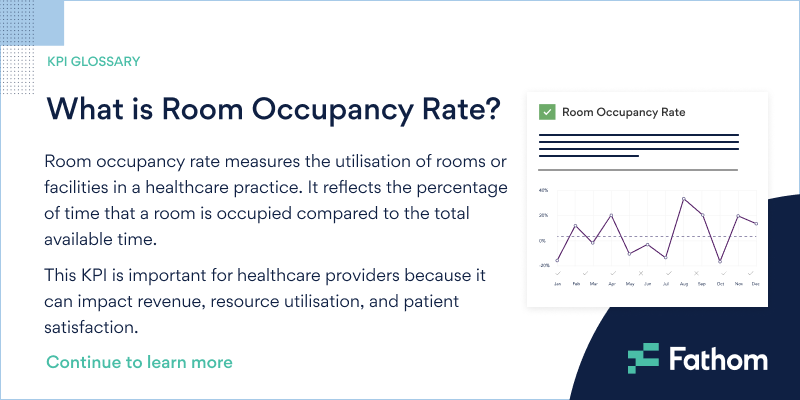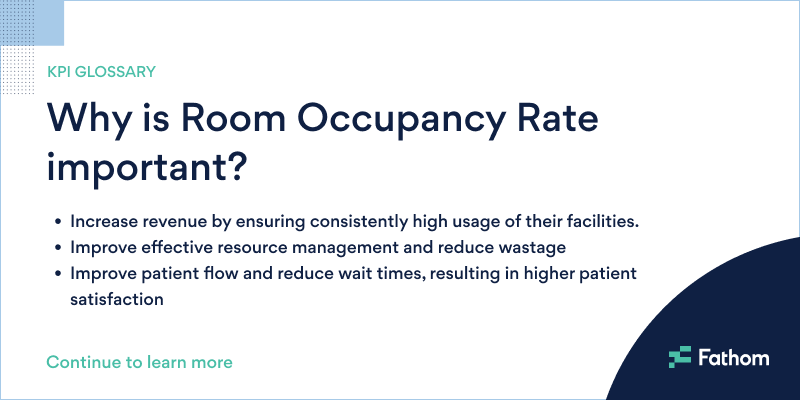
Running a medical practice is a complex undertaking, and there are countless metrics to track and analyse to ensure success. From patient satisfaction to revenue growth, it can be difficult to know where to focus your efforts. However, one key performance indicator (KPI) that should not be overlooked is that of room occupancy rate.
Room occupancy rate measures how efficiently you are using the available space in your practice. Simply put, it tracks the percentage of time that each exam room or consultation room is in use during your operating hours. By maximising your room occupancy rate, you can increase the number of patients you see each day, which in turn can drive revenue growth and improve the overall patient experience.
In this blog post, we'll dive deeper into the power of room occupancy rate as a KPI and show you how to use it to maximise the potential of your practice. We'll discuss best practices for tracking and analysing your room occupancy rate, as well as strategies for improving it over time. If you're ready to take your medical practice to the next level, keep reading and learn how to leverage this important metric to drive success.
"Tracking room occupancy rate is an essential KPI for healthcare providers, as it directly impacts the efficiency and profitability of the practice. By optimising room utilisation, healthcare providers can improve patient satisfaction, increase revenue, and optimise resources, ultimately leading to better patient outcomes."
- Dr. Karen DeSalvo, Former Acting Assistant Secretary for Health at the U.S. Department of Health and Human Services.
Room occupancy rate measures the utilisation of rooms or facilities in a healthcare practice. It reflects the percentage of time that a room is occupied compared to the total available time.
It is calculated by dividing the total time a room was occupied by the total available time and multiplying it by 100 to get a percentage.
This KPI is important for healthcare providers because it can impact revenue, resource utilisation, and patient satisfaction. By tracking your room occupancy rate, healthcare providers can identify areas of improvement and implement strategies to increase usage, improve patient flow, and optimise resources.
Tracking the room occupancy rate KPI is important as it can impact revenue. If rooms or facilities are not being used to their full potential, this can result in lost revenue for the practice. By tracking and improving the occupancy rate, healthcare providers can increase revenue by ensuring consistently high usage of their facilities.
Secondly, tracking room occupancy rate can help improve resource utilisation. If certain rooms or facilities are not being used as much as others, healthcare providers can identify these areas and implement strategies to improve effective resource management and reduce wastage.
Finally, your room occupancy rate can also impact on patient satisfaction. Patients who are kept waiting in unoccupied rooms may feel frustrated and dissatisfied with their experience. By focusing on increasing the occupancy rate, healthcare providers can improve patient flow and reduce wait times, resulting in higher patient satisfaction.

There are several limitations to consider when measuring your room occupancy rate. One limitation is that it may not consider the quality of care provided in the occupied rooms. Just because a room is occupied does not necessarily mean that the care provided in that room is of high quality. Therefore, it is important to consider other metrics such as patient outcomes and patient satisfaction to get a complete picture of the practice's performance.
Another limitation is that it may not be a good indicator of demand for certain services. For example, a room may be occupied for an extended period of time due to a complicated medical case, but this does not necessarily reflect a high demand for that particular service. Therefore, it is important to consider other metrics such as patient volume and appointment wait times to get a more accurate picture of demand.
Finally, it’s important to note that this KPI may also be impacted by external factors such as seasonal fluctuations or unexpected events, which may skew the data and make it difficult to draw accurate conclusions. Therefore, it is important to consider trends over a longer period of time along with any external factors that may impact your room occupancy rate.
To calculate room occupancy rate, follow these steps:
The formula is:
For example, if a practice has a room that is available for 10 hours per day, and that room is occupied for 8 hours per day, the room occupancy rate would be:
Room occupancy rate = (8 / 10) x 100 = 80%

When tracking the room occupancy rate, the targets you are trying to achieve can vary depending on the type of practice and the services provided. However, as a rule of thumb, a good target is around 85% or higher. This means that the room or facility is being used effectively and efficiently, and there is minimal downtime or wasted resources.
However, it is important to note that this KPI should not be viewed in isolation and should be considered alongside other metrics such as patient outcomes, patient satisfaction, and revenue generation. It is also important to take into account any external factors that may impact on the occupancy percentage, such as seasonal fluctuations or unexpected events. By taking a holistic approach to measuring performance, healthcare providers can ensure that they are providing the highest quality of care while maximising resources and optimising revenue.
There are several common errors that can occur when measuring room occupancy rate for the practice:
Improving room occupancy rate requires a multifaceted approach that involves improving patient scheduling, streamlining patient flow, using technology to manage appointments, implementing a cancellation policy, and monitoring and analysing performance. By taking a holistic approach to performance management, healthcare providers can ensure resource efficiency, improve patient care, and increase revenue generation.
Optimise scheduling
Scheduling is a critical factor in maximising your room occupancy rate. By ensuring that appointments are properly scheduled, and patients are seen promptly, you can minimise wait times and reduce the likelihood of cancellations or no-shows.
Streamline patient flow
By optimising the flow of patients through your practice, you can reduce bottlenecks and minimise downtime. This can include strategies such as reducing paperwork, using electronic health records, and ensuring that staff are properly trained.
Use technology to manage scheduling
Using scheduling software or electronic health records can help to automate scheduling and reduce errors. This can help to ensure that patients are seen promptly and that appointments are properly managed.
Implement a cancellation policy
By implementing a cancellation policy that requires patients to provide notice before cancelling an appointment, you can reduce the likelihood of cancellations or no-shows. This can help to improve your room occupancy rate and reduce wasted resources.
Monitor and analyse performance
By regularly monitoring and analysing your room occupancy rate, you can identify areas for improvement and make changes to improve performance. This can include tracking wait times, analysing appointment data, and measuring patient satisfaction.
Appointment Wait Time: This measures the amount of time that patients wait to see a healthcare provider after scheduling an appointment.
Turnaround Time: This measures the amount of time it takes to complete a particular task or process, such as laboratory tests or diagnostic imaging.
Patient Satisfaction: This measures the level of satisfaction that patients have with their healthcare experience. By improving patient satisfaction, healthcare providers can improve patient loyalty, attract new patients, and thereby improve overall reputation.
While each of these KPIs measures different aspects of healthcare performance, they all share a common goal: to optimise resource efficiency, improve patient care, and maximise revenue generation. By using a combination of these KPIs, healthcare providers can gain a comprehensive understanding of their performance and identify areas for improvement.
Q: What does room occupancy rate KPI mean?
A: The room occupancy rate KPI is a metric that measures the percentage of rooms that are occupied at a given time. It is commonly used in healthcare settings to optimise resource efficiency and improve patient care.
Q: How is room occupancy rate calculated?
A: Room occupancy rate is calculated by dividing the number of rooms that are occupied by the total number of rooms available, and multiplying the result by 100 to get a percentage.
Q: Why is room occupancy rate important for healthcare providers?
A: Room occupancy rate is important for healthcare providers because it helps them to optimise resource efficiency, improve patient care, and maximise revenue generation. By tracking this KPI, healthcare providers can identify areas for improvement and make data-driven decisions to improve their performance.
Q: What is a good benchmark for room occupancy rate?
A: The benchmark for room occupancy rate can vary depending on the type of healthcare facility and the services offered. Generally, a rate of 85% or higher is good, while a rate of 70% or lower may indicate that there is room for improvement.
Q: What are some common errors when measuring room occupancy rate?
A: Some common errors when measuring room occupancy rate include not including all available rooms in the calculation, not accounting for rooms that are out of service for maintenance or repairs, and not considering the time of day or week when calculating the rate.
Q: How can healthcare providers improve their room occupancy rate?
A: Healthcare providers can improve their room occupancy rate by improving patient flow and scheduling and reducing wait times. They can also implement strategies to reduce the likelihood of cancellations or no-shows, such as sending appointment reminders to patients.